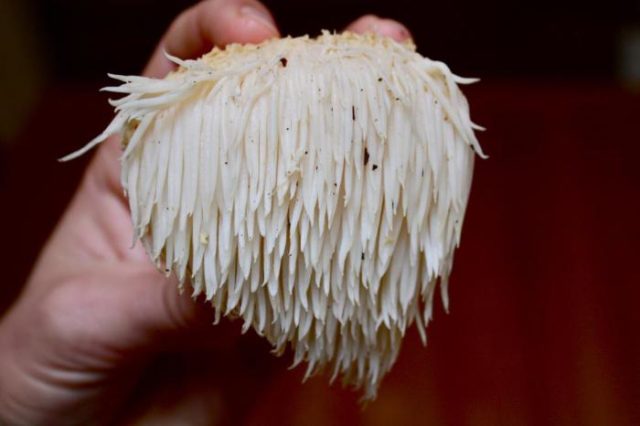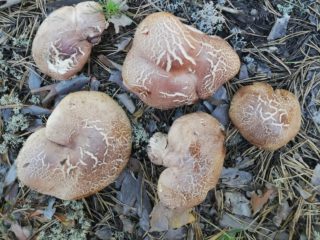Content
The comb mushroom is a beautiful, recognizable and quite rare mushroom with numerous beneficial properties. To evaluate the valuable qualities of the combed hedgehog, you need to study its description and characteristics.
Description of the combed hedgehog
The combed urchin, also called the combed hericium, "mushroom noodle" and "grandfather's beard", has a very recognizable external structure.
The fruiting body consists mainly of a large cap - it is round or pear-shaped in shape, elongated, slightly compressed on the sides. The size of the fruiting body can reach 20 cm, and the weight sometimes reaches 1.5 kg. The color of the mushroom varies from light beige to cream, sometimes yellow or light brown fruiting bodies are found; mushrooms usually darken already in adulthood.

The combed hedgehog is almost impossible to confuse with another mushroom
The combed hedgehog got its name due to its unusual hymenophore, which makes it look like a hedgehog. The fruiting body of the mushroom is densely covered with long spine-like needles hanging down; they are cylindrical in shape and can reach 5 cm in length. The shade of the needles is also light cream or beige.
When broken, the flesh of the combed hedgehog has a whitish color and is fleshy in structure. The pulp does not change color when exposed to air, but when it dries it turns yellow and becomes hard.
Where and how does it grow
On the territory of Russia, comb hericium can be found mainly in the Khabarovsk Territory, Primorye, Crimea and the Caucasus, Western Siberia and the Amur region. All over the world, the mushroom is found in America and Europe, in Asian countries.
The combed hedgehog settles on tree trunks, both dead and living. The mushroom mainly chooses birch, oak and beech trees for its growth, and mass fruiting is observed from mid-summer to early October.
Important! Although the combed hedgehog is geographically distributed throughout Russia, in practice it can be found quite rarely; the species is listed in the Red Book and is classified as an endangered species.

Hericium comb is one of the very rare mushrooms listed in the Red Book.
Doubles and their differences
The appearance of the comb hericium is very recognizable, and it is almost impossible to confuse it with other mushrooms. However, the fungus bears certain similarities to several related species.
Antennae hedgehog
The similarity between the species lies in the similar structure of the hymenophore. The cap of the antennal hedgehog is also covered with long thick spine-like needles with sharp tips hanging down. The species are similar in shade. Both the combed and antennal hedgehogs have a light beige or cream colored cap and spines.
But unlike the comb type, the tendril type usually grows in a tiled pattern, with several caps located on top of each other. They are smaller in size than the comb hericium, each of them usually does not exceed 12 cm in diameter.
The tendril mushroom is an edible mushroom and is suitable for food consumption. But you can eat it only at a young age; as it ages, the pulp becomes too hard and unpleasant to the taste.
Coral hedgehog
Another similar species is the coral-shaped hedgehog, vaguely reminiscent of the comb hericium in structure and color. The fruiting bodies of both species grow on trees and are light in color and have unusual shapes. But it’s very easy to distinguish them - the coral hedgehog’s needles are directed not downwards, but in all directions, and at first glance it resembles a coral bush, and not a hanging noodle.
Coraloid hericium is also suitable for food use.It can be consumed, like other hedgehog mushrooms, at a young age, while the mushroom pulp has not yet dried out.
Is the mushroom edible or not?
Comb hericium belongs to the category of edible mushrooms, but with one caveat. You can only eat young fruiting bodies whose flesh is quite tender. The mushroom is considered a delicacy - its taste is sweetish, very refined and reminiscent of seafood.
The cost of wild combed hedgehogs can reach 5 thousand dollars; therefore, the fruiting bodies for sale are grown mainly artificially.
How to prepare combed hedgehog mushrooms
Despite its absolute edibility, comb hericium requires careful processing before cooking. It consists in removing all damaged, darkened, deformed or rotten thorns from the fruiting body.
After this, the mushroom is immersed in a pan of boiling water and left for 5 minutes, and then caught with a slotted spoon and allowed to cool slightly. Heat-treated blackberry can be further prepared according to several basic recipes.

Before cooking the blackberry, you need to remove all the darkened thorns from it.
Boiling
Most often, the hedgehog is used in cooking in boiled form. It is added to salads, soups and main courses. If the mushroom needs to be boiled, then during the initial processing it is not removed from the pan after 5 minutes, but is left to boil for 15-20 minutes, depending on the size of the fruiting body.
During the cooking process, carrots, onions and potatoes are added to the mushroom pulp and chicken, resulting in a very tasty and healthy soup.
Pickling
Another popular cooking recipe is pickling, which allows you to preserve the valuable properties of the mushroom throughout the winter. The hericium is pre-boiled, and at the same time the sauce is prepared - mix 2 large spoons of salt with 1 spoon of sugar, 4 spoons of vinegar and 3 chopped cloves of garlic.
The sauce is brought to a boil and turned off almost immediately, and the boiled mushroom is cut into small pieces and placed in a glass jar. Peppercorns, cloves and bay leaves are added to the blackberry to taste, the ingredients are poured with hot marinade and the jars are rolled up. After cooling, the workpiece should be stored in the dark and cool, and pickled hericium can be consumed 3-4 weeks after preparation.

Pickled blackberry can be stored all winter
Frying
Fried hericium is considered one of the most delicious. The cooking recipe looks like this:
- the pre-processed mushroom is cut into small pieces;
- Heat the oil in a frying pan, cut the onion into half rings and fry until transparent;
- then add pieces of blackberry and fry until the onion acquires a golden hue.
After this, remove the pan from the stove, allow the mushrooms to cool slightly and add a little chopped garlic to them before serving. Fried blackberries go well with potatoes, cereals, pasta and baked meat.
Medicinal properties of combed hedgehogs
Eating hericium comb is not only tasty, but also beneficial for the health of the body. The unusual mushroom has numerous medicinal properties, and this further increases its value.
In China, hericium comb is considered a natural medicine that promotes healthy brain and nervous system function.In folk medicine, fruiting bodies are recommended to be consumed:
- for gastritis and stomach ulcers;
- for diseases of the liver and pancreas;
- for diseases of the respiratory organs;
- with weakened immunity and chronic fatigue;
- with a tendency to depression and increased anxiety.
The anticancer properties of combed hedgehogs deserve special mention. It is believed that the mushroom has a beneficial effect on the body in case of leukemia and esophageal cancer, pancreatic cancer, fibroids and fibroids, cysts, liver cancer, and mammary tumors. The use of comb hericium during chemotherapy can reduce the negative impact of treatment on the body.
Also, combed hedgehog is good for brain function. Studies have shown that the mushroom restores the function of brain cells and prevents the development of sclerosis, and can also be used to treat Alzheimer's disease.

Hericium comb is highly valued in medicine
Is it possible to grow combed hedgehogs in the country?
Since the fruiting bodies of hericium are very rare in nature and, moreover, are most often prohibited for collection, the combed hedgehog is often grown in the country. You can order mushroom mycelium in specialized stores or via the Internet, and hedgehog mushrooms are bred in accordance with the following rules:
- To grow the mushroom, a fresh leafy log is soaked for a couple of days and then left for a week in a warm, well-ventilated room.
- Then small depressions no more than 4 cm in depth and 1 cm in diameter are made in a checkerboard pattern in the log. The gap between them should be about 10 cm.
- The purchased mycelium is carefully placed in these holes, and then the logs are wrapped in polyethylene with holes made for air and left in the shade and warm.
- Once every 4 days, the logs are moistened so that they do not dry out, and when the first white threads of the mycelium appear, they are soaked in cold water for a day.
After this, the logs are placed vertically and left in a warm and shaded place. For the winter, plantings of combed hedgehog should be placed in a barn or basement. The first harvest can be harvested after about 9 months; it is better to cut the fruiting bodies young and fresh. After the first collection of mushrooms, the logs with blackberry stop being watered for 2-3 weeks, and then watering is resumed. Subsequently, the rare mushroom bears fruit in waves, and the fruiting bodies are collected as they appear, each time without waiting until they are completely ripe and dry.

You can grow a rare mushroom in your summer cottage
Important and interesting facts about combed hedgehogs
Comb hericium is one of the rarest types of mushrooms and is officially listed in the Red Book. Usually it cannot be collected even in those places where it is found in the forest under natural conditions.
Many countries impose strict penalties for picking the mushroom. Thus, in the UK, collecting combed hedgehogs is punishable by unlimited fines and imprisonment for up to six months.
In China, hericium comb is a recognized remedy for stomach disorders and weakened immunity. Mushroom extract is included in many medicines with a tonic and hematopoietic effect.
Comb hericium has antiparasitic properties. The mushroom is recommended for use against helminths, as it helps to quickly remove parasites from the intestines.
In the late 1990s, research in Germany isolated the substance erinacin E, a compound that stimulates the growth of nerve cells, from the combed hedgehog. Thus, the hedgehog has acquired enormous medicinal importance. The mushroom has great potential - scientists think that in the future it will be able to help in the treatment of many diseases of the central nervous system that were previously considered incurable.

In some countries, collecting hedgehogs is punishable by huge fines.
Conclusion
The combed hedgehog is an unusual, beautiful and very useful mushroom, listed in the Red Book. Although it is impossible to collect it in the forest in most regions, it is quite possible to grow hedgehog grass from spores in your own summer cottage. The value of the mushroom lies not only in its delicious taste, but also in its medicinal properties.










